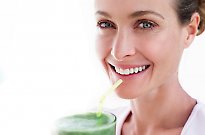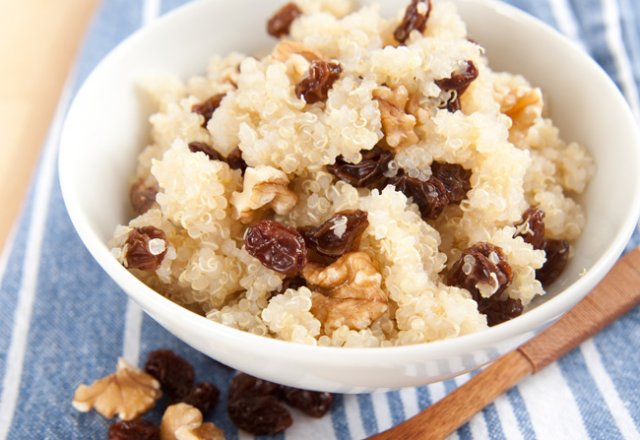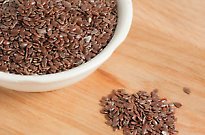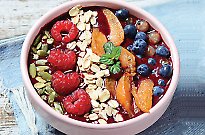
Breakfast ideas for better health

Breakfast fuels us for the day ahead and helps us maintain healthy weight ratios. Our morning meal choices can also help make a real difference to our health in other ways – from our skin and muscle tone to our mental wellbeing and immune system.
A healthy breakfast should comprise wholegrains, proteins and antioxidants.
“Breakfast is the one meal that most people tend to get wrong,” says nutritionist and Eat Yourself Sexy consultant, Emma Sutherland. “Most people actually do very well with their other meal choices but drop the ball when it comes to the morning meal.”
School drop-offs, long commutes and early meetings can mean healthy breakfasts take a back seat most days, for most people. As a result, the first meal tends to come in three forms: refined, rushed, or a combination of the two – welcome to the breakfast rut.
For those stuck in it, thinking outside the…er…cereal box may be the key to a morning meal makeover and better health.
Sow the seeds.
Eating better at breakfast time needn’t involve making big changes – in fact it’s the tiny things, like adding seeds, that can boost meal flavour, interest and nutritional value.
“Quinoa seeds have a low GI and are high in fibre, which helps keep us fuller for longer, and chia seeds and flax seeds have essential fatty acids and their extra protein content also helps keep us strong and lean and our metabolism firing,” says Georgie Rist, accredited practising dietitian and spokesperson for the Dietitians Association of Australia.
“They’re great in omelettes and whole grain cereals, or to thicken up a lighter breakfast such as a berry smoothie. Adding sunflower seeds or even oats to smoothies makes you feel as if you are actually eating something as well.”
Rist suggests including superfoods, too. “Porridge with raw cacao powder and goji berries or quinoa with brown rice flakes are particularly great and also good for coeliacs,” she says.
Sutherland also emphasises the role of minerals such as magnesium and zinc in foods like quinoa and pumpkin seeds. “I really encourage my patients to use pumpkin seeds as brekky boosters, especially because they are really high in the mineral zinc – probably the highest of all seeds. But they also have lots of the fat-soluble antioxidant vitamin E. So for all those ladies wanting luxurious skin, pumpkin seeds are great to add in if you have eczema, arthritis, acne or any kind of skin complaint,” she says.
Smooth and Green
Greens at breakfast are a perfect way to introduce the five veg and three fruit we need daily. Vegetables are also alkaline and neutralise the acid (introduced by foods such as meat and dairy products) that can increase in the body while we sleep.
“Too often we find breakfast is lacking in vegies, so increase green, leafy veg from the beginning. Try eggs on wholegrain with spinach and tomatoes or add capsicum and zucchini to omelettes, or grate veg on top of wholegrain toast and then add in poached eggs,” says Rist.
But if the idea of eating leafy vegetables first thing in the morning is a tad hard to accept, think about drinking them down instead. It could be as simple as “Try kelp or spinach in smoothies or add celery to fruit and veg juice,” Rist suggests, or, as Sutherland proposes, making drinks with supergreens such as spirulina and chlorella.
Favour fermentation
For an acid-neutralising boost that supports the immune system, Sutherland swears by kefir – a traditional Turkish fermented yogurt drink at breakfast time. “It’s jam-packed with friendly probiotics, but also with yeast. Some people may shudder at the thought of bacteria and yeast, but what this combination actually does is reduce all those carcinogenic micro-organisms. So, for people who have things like candida or constant coughs and colds and the flu, kefir is really good,” she says.
Miso soup – yes, soup is not just for lunch and dinner – is another probiotic source that can help build resilience. Strongly advocating soup as part of the ideal breakfast, Donna Gates, author of The Body Ecology Diet, points out that: “Having warm soup in the morning stimulates digestion, igniting your ‘digestive fire’ and prepares your digestive tract for later meals.”
Alternate milks
Finally, non-dairy milks are a heaven-send for porridge-eaters or smoothie-drinkers with intolerances to dairy products. However, the proliferation of soy, nut, hemp, rice and oat milks also means more versatility for everyone. The tastes and textures they lend smoothies or porridges are a boon to those fed up with bland concoctions. Pureharvest’s oat milk, for instance, adds depth of flavour, and an extra fibre hit to a bowl of oats.
Living Synergy Retreat host and producer of nut milk bags, Jenny Keenan, says you can’t go past nut milks in smoothies – whether green or fruit-based. “For instance, to add zing to my chia puddings, I flavour the milk with vanilla, cinnamon and honey and then pour it over chia seeds,” she says.
Green Smoothie
For a simple smoothie that also presents a quick and easy way to get more greens, Sutherland suggests combining kale, pear, a banana and water.
Tools
To make your own milk, try Keenan’s tips for using nut milk bags.
“Nut milk is extremely easy to make. Just soak the nuts overnight, place in a good blender with some water, then blend and strain it through the bag.
“The more water you have, the more watery the milk will be. So, many people tend to use anywhere from one part of nuts to six parts water. If you want it to be creamier you can reduce the water to make it richer. It can take a little while to do, but can last three to four days.
“If you use a good blender, you’ll get a much creamier nut milk, whereas a cheaper blender can make it more watery.
“A green juice is a great way to start the day. Making it with nut milk bags makes it easier to clean up and you can easily flavour things with vanilla and cinnamon,” she says. NH
NEXT: Breakfast boosters>>
Author: Jenan Taylor; Photo credit: Thinkstock


